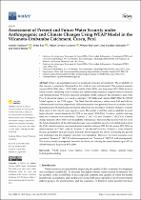Mostrar el registro sencillo del ítem
Assessment of Present and Future Water Security under Anthropogenic and Climate Changes Using WEAP Model in the Vilcanota-Urubamba Catchment, Cusco, Perú
| dc.contributor.author | Goyburo, Andrés | |
| dc.contributor.author | Rau, Pedro | |
| dc.contributor.author | Lavado-Casimiro, Waldo | |
| dc.contributor.author | Buytaert, Wouter | |
| dc.contributor.author | Cuadros-Adriazola, José | |
| dc.contributor.author | Horna, Daniel | |
| dc.date.accessioned | 2023-09-14T19:07:48Z | |
| dc.date.available | 2023-09-14T19:07:48Z | |
| dc.date.issued | 2023 | |
| dc.identifier.uri | https://hdl.handle.net/20.500.12542/2912 | |
| dc.description.abstract | Water is an essential resource for social and economic development. The availability of this resource is constantly threatened by the rapid increase in its demand. This research assesses current (2010–2016), short- (2017–2040), middle- (2041–2070), and long-term (2071–2099) levels of water security considering socio-economic and climate change scenarios using the Water Evaluation and Planning System (WEAP) in Vilcanota-Urubamba (VUB) catchment. The streamflow data of the Pisac hydrometric station were used to calibrate (1987–2006) and validate (2007–2016) the WEAP Model applied to the VUB region. The Nash Sutcliffe efficiency values were 0.60 and 0.84 for calibration and validation, respectively. Different scenarios were generated for socio-economic factors (population growth and increased irrigation efficiency) and the impact of climate change to evaluate their effect on the current water supply system. The results reveal that water availability is much higher than the current demand in the VUB for the period (2010–2016). For short-, middle- and long term, two scenarios were considered, “Scenario 1” (RCP 4.5) and “Scenario 2” (RCP 8.5). Climate change scenarios show that water availability will increase. However, this increase will not cover the future demands in all the sub-basins because water availability is not evenly distributed in all of the VUB. In both scenarios, an unmet demand was detected from 2050. For the period 2071–2099, an unmet demand of 477 hm3/year for “Scenario 1” and 446 hm3/year for “Scenario 2” were estimated. Because population and agricultural demands are the highest, the effects of reducing the growth rate and improving the irrigation structure were simulated. Therefore, two more scenarios were generated “Scenario 3” (RCP 4.5 with management) and “Scenario 4” (RCP 8.5 with management). This socio-economic management proved to be effective in reducing the unmet demand up to 50% in all sub-basins for the period 2071–2099. © 2023 by the authors. | es_PE |
| dc.format | application/pdf | es_PE |
| dc.language.iso | spa | es_PE |
| dc.publisher | MDPI AG | es_PE |
| dc.rights | info:eu-repo/semantics/openAccess | es_PE |
| dc.rights | Atribución-NoComercial-SinDerivadas 3.0 Estados Unidos de América | * |
| dc.rights.uri | http://creativecommons.org/licenses/by-nc-nd/3.0/us/ | * |
| dc.source | Repositorio Institucional - SENAMHI | es_PE |
| dc.source | Servicio Nacional de Meteorología e Hidrología del Perú | es_PE |
| dc.subject | Cambio Climático | es_PE |
| dc.subject | Hydrological Modeling | es_PE |
| dc.subject | Water Balance | es_PE |
| dc.subject | Modelos y Simulación | es_PE |
| dc.subject | Modelamiento Hidrológico | es_PE |
| dc.title | Assessment of Present and Future Water Security under Anthropogenic and Climate Changes Using WEAP Model in the Vilcanota-Urubamba Catchment, Cusco, Perú | es_PE |
| dc.type | info:eu-repo/semantics/article | es_PE |
| dc.identifier.doi | 10.3390/w15071439 | |
| dc.subject.ocde | https://purl.org/pe-repo/ocde/ford#1.05.11 | es_PE |
Ficheros en el ítem
Este ítem aparece en la(s) siguiente(s) colección(es)
-
Artículo científico [166]









